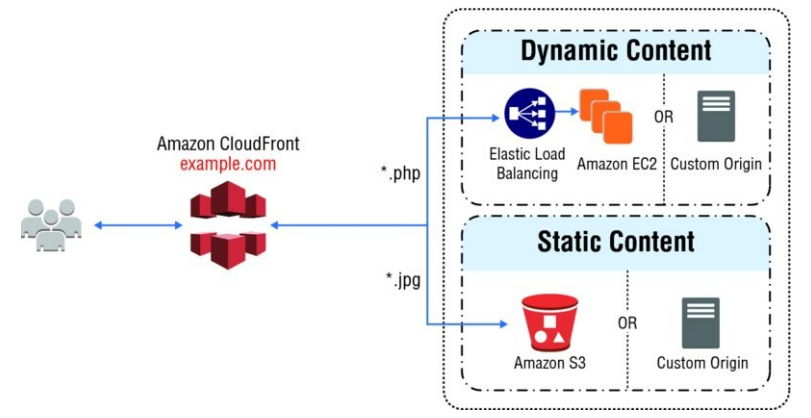Amazon CloudFront – What it is and how it makes a difference?
Amazon CloudFront is a Content Delivery Network (CDN). A CDN is a network of linked servers that helps data-intensive applications by accelerating the loading speed for image or video heavy web pages. Data from a website’s server must go across the internet to reach a user’s computer when they visit a website. A big file, like a video, or .html, .css, .js, and image files will take a while to load if the user’s location is not close to the server. Hence, the website’s material is kept in close proximity to the users’ locations. That further speeds up the process of getting it to their devices
What are the fundamental benefits of content delivery networks (CDNs)?
TThe use of content delivery networks (CDNs) can enhance website performance and support essential network infrastructure in numerous ways. A CDN can carry out the following tasks, for instance:
A CDN can carry out the following tasks, for instance:
- If the loading times of pages are excessively long, website traffic may decline. A CDN can decrease bounce rates and lengthen users’ stay on your website.
- A website may crash due to an excessive number of simultaneous visitors or hardware issues with the network. More web traffic may be handled by CDN services, which also lightens the stress on web servers. Additionally, other active servers can step in to maintain service when more than one CDN server is offline.
- DDoS attacks aim to shut down apps by flooding the website with a massive volume of fake traffic. By spreading the strain across several intermediary servers, CDNs can manage such traffic spikes while lessening the impact on the main server.
What kind of content can a CDN deliver?
Static Content
Data on a website that remains constant from one user to the other is known as static content. The company doesn’t change the website’s header graphics, logos, or font styles too regularly, so they are consistent for all users. A CDN is the best place to store static data because it doesn’t need to be changed, processed, or created.
Dynamic Content
Users of a website may differ in their preferences for dynamic content, including social networking news, feeds, weather forecasts, status concerning logging in, and chat messages. This information changes depending on users’ location, login time, or preferences. Furthermore, the website is required to produce this information for every user interaction that takes place.
What is the importance of edge location in Amazon CloudFront?
AWS data centers called edge locations are built to provide services with the least amount of latency as feasible. These data centers are located worldwide and are owned by Amazon. They are frequently located in large cities and are close to users than several Availability Zones, allowing for quick replies.
How to deploy Amazon CloudFront to deliver content?
- First, the origin servers are designated from which CloudFront obtains the files, which are disseminated globally from CloudFront edge sites, such as an Amazon S3 bucket or a user’s HTTP server. The original, unaltered copy of objects is kept on one of the origin servers. The origin server, if anyone is serving content over HTTP, can either be an HTTP server which might include a web server or an Amazon S3 bucket.
- The original servers receive the files one uploads, which are also known as objects. The objects can be anything that HTTP could offer. These are typically web pages, photos, and media files. Making one’s items of Amazon S3 bucket publicly viewable enables anyone with access to view them if they’re a user using it as their origin server. In addition, one can decide who has access to certain items and keep them secret.
- Moreover, to notify CloudFront of the origin servers, it needs to utilize to obtain files when people access a website or application; first, a CloudFront distribution must be created. People can also select information like whether or not they want CloudFront to navigate all requests and whether or not they want the distribution to be enabled the moment it comes to life.
- Next, the new distribution is given a domain name by CloudFront, which the user may view in the CloudFront console. It might also be returned after acquiring a response to a certain programmatic request, such as an API call. Users can also substitute another domain name if they prefer.
- The configuration of the user’s distribution is sent to all POPs of CloudFront. These are clusters of servers in geographically distributed data centers where CloudFront stores copies of people’s files but not their content.
Basic CloudFront Architecture

Why should one choose Amazon Web Services?
- AWS has the greatest selection of certain databases that are created specifically for certain applications. It allows one to select the best tool for the task that offers optimum performance at a competitive price.
- AWS is designed in such a manner that makes it adaptable for a safe cloud computing environment.
- Businesses can rely on AWS for their most crucial applications because it has unrivaled experience, security, maturity, dependability, and performance.
Conclusion
To be precise, CloudFront distributes content through an international network of data centers referred to as edge locations. When a user requests material that one is serving with CloudFront, the request is further directed to the edge location having the lowest latency. It helps to ensure that the content is provided with the optimum performance.
Comment (1)
Comments are closed.










uk produced tadalafil
January 13, 2024uk produced tadalafil
uk produced tadalafil